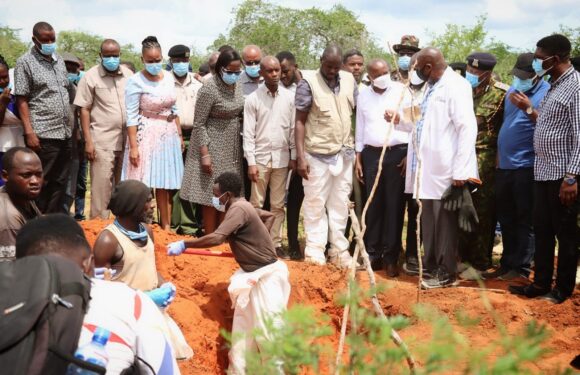
By Fredrick Nzwili
NAIROBI, Kenya (OSV News) — As the death toll in what is becoming known as the “Shakahola starvation massacre” in Kenya hit 110, religious leaders in the region are finding that the majority of victims are children. They also suspect that not all of the victims died from starvation.
All victims were followers of the Good News International Church Pastor Paul Mackenzie, who told his followers to pray and fast to meet Jesus, and that the world would end April 15. Mackenzie currently is in police custody.
The bodies were found in over 50 graves on the 800-acre ranch in Kilifi County in eastern Kenya, Interior Minister Kithure Kindiki said April 27. More than 350 people, including almost 200 children, have been reported missing by families, the Kenya Red Cross Society in Malindi said. The search for more graves was suspended due to heavy rains in the region, but was set to resume the first week of May.
Mackenzie, a 51-year-old charismatic preacher from Malindi town, allegedly told his followers to pray and fast to “meet Jesus.” Many of them — individuals who lived on the ranch where mass graves were discovered in April — died of starvation after going for weeks without food. But officials have raised concerns that some of the victims did not die from fasting.
“The preliminary reports we are getting is that some of the victims may not have died of starvation. There were other methods used, including hurting them, just by physical and preliminary observations,” Kindiki told reporters.
“Religious leaders call for investigations whether the bodies being retrieved from the graves in Shakahola are of people who died of starvation or they were brought there,” Bishop Willybard Kitogho Lagho of Malindi told OSV News in an interview April 28.

According to the bishop, the leaders want to know to what extent the pastor had followers beyond Kilifi County.
Mackenzie had delivered apocalyptic messages in online sermons. He also carried out exorcism to cast out demons tormenting members of his church. His recordings available online warn of “imminent doom,” the “end of the world” and the “dangers of science.” He had preached against education, and had discouraged children from attending school.
Why he had so much interest and focus on children has baffled Kenyans.
“The leaders also want to know why there are more children who are missing or dead” in the Shakahola massacre, Bishop Lagho said.
The bishop explained that the pastor has used his followers inside Shakahola to bait relatives and friends.
“Sometimes not just for healing. Many of those who entered the forest never came out. Whether they were sold land, made to pay for it and then killed, is something to be investigated,” the bishop said.
He called for expert analysis of sermons by pastors on both “faith healing” and on the dangers of conventional medicine.
“If people were dying of a disease that could be healed through conventional medicine simply because they were misled to abandon conventional medicine for faith healing, then that is a very big threat,” Bishop Lagho told OSV News.
Some religious leaders want the government to empower them to impose their own regulations and remove the “rotten apples” among them. In the past, such proposals were met with resistance from some Pentecostal and charismatic church leaders.
Attempts to regulate religious organizations in Kenya often take a political twist. While such government moves can be criticized as attempts to stifle freedom of religion, some politicians voice support for such actions, since many of their voters are members of those churches.
Catholic leaders in Kenya urged that the Shakahola starvation massacre not trigger a hate campaign against religion in general.
“We caution against the blanket condemnation of the church, Christianity or religion in general as a result of these events. … Latching onto a tragedy like the present one to engage in anti-Christian, anti-religious or anti-theistic bashing is neither decent nor helpful to the victims or society at large,” Charles Kanjama, a Catholic lawyer and chairman of Kenya Christian Professional Forum, said in statement April 29.
“We insist that it is possible to uphold the freedom of religion guaranteed in the Kenyan constitution, while preventing criminals from using the same to their advantage,” he said.
